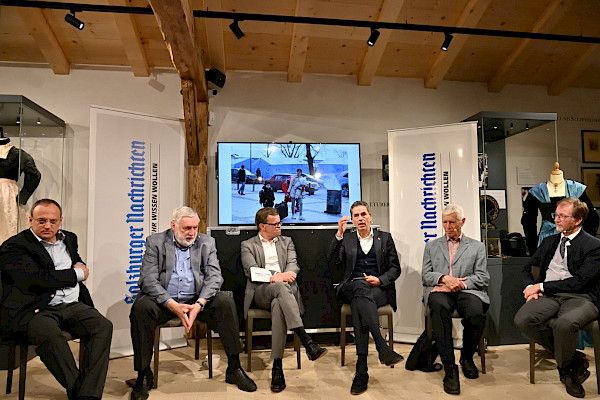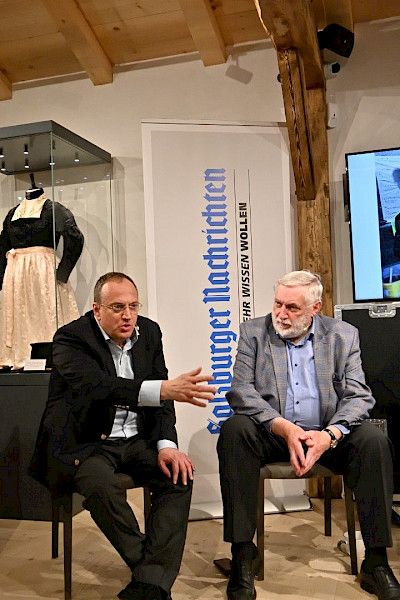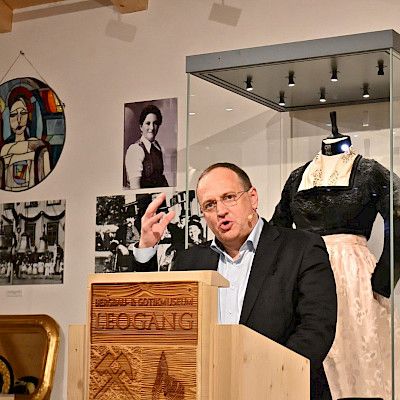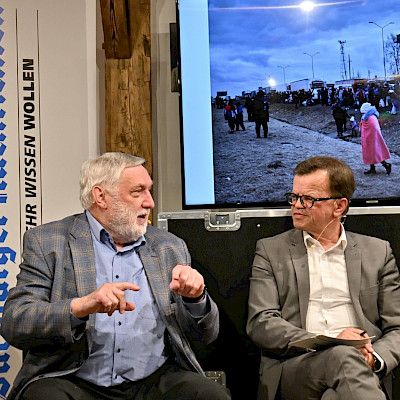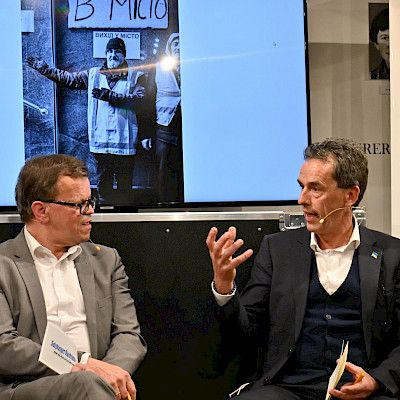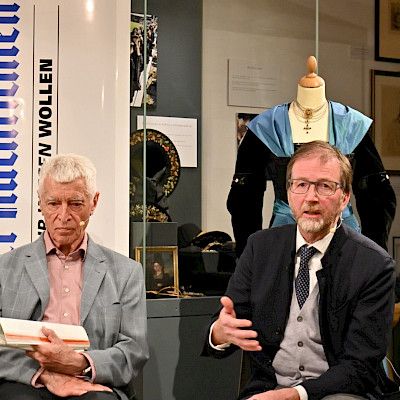The war in Ukraine did not come as a surprise. Over 150,000 Russian soldiers near Ukraine’s borders with heavy military equipment and an increasing number of warnings from the U.S. American and British governments already suggested in January 2022 that armed conflict was imminent. Cyber attacks on Ukrainian banks and ministries frequently occurred and bomb threats against schools and public institutions had increased in Ukraine. The Austrian embassy was also affected and had to be temporarily evacuated and searched for bombs.
What did come as a surprise was the extent of the invasion. We assumed that the armed conflict would take place in Eastern Ukraine, in the separatist regions, in the occupied provinces of Luhansk and Donetsk. Putin might even start another attempt to secure a land corridor to the Crimean peninsula and take the strategically important port city of Mariupol. A land corridor between Crimea and the occupied region of Eastern Ukraine is of utmost importance for the supply of the peninsula. However, none of us expected that Kharkiv would be destroyed or that Kyiv and many other cities would be bombed and surrounded.
The invasion and the war had been well prepared in ideological and military terms. Putin’s timing was not arbitrary: The USA is losing its world superpower status and displayed weakness by withdrawing from Afghanistan. Putin certainly also considered it advantageous that Europe was exhausted by the refugee crisis and the pandemic, that France was preparing for elections and that Germany had a new and inexperienced government coalition.
The fact that democracy and liberality were thriving on his own doorstep was the biggest threat to Putin. NATO did not threaten Russia, but the fact that Ukraine was a successful democratic and liberal country did. And this at a time of economic decrease, increasing poverty and demographic regression in Russia.
The Russo-Ukrainian War is not Putin’s first war. Just think of the First and Second Chechen Wars in the late 1990s (with the destruction of Grozny), the Russo-Georgian War in August 2008, the Syrian Civil War (with the destruction of Aleppo), the annexation of Crimea (2014) and the Luhansk and Donetsk regions where Putin sent either the Russian army or mercenary forces (the Wagner Group). In military terms, the invasion was hence well-tested and also well-prepared by a massive troop build-up near Ukraine’s borders in autumn 2021. However, Putin seems to have underestimated the Ukrainians and their will to fight.
The strategic preparation for this war included yearlong efforts to divide Europe. Putin paid politicians and funded political parties, instigated and authorized cyber attacks, for example on the German Foreign Office, and had his propaganda machine run at full throttle (e.g. ”Russia Today” and the troll attacks on social media). The dependence on Russian fossil fuels and other commodities as well as the close economic ties of many European banks and industrial companies with Russia resulted in many votes against the tightening of EU sanctions and consequent isolation of the Russian economy in 2014 (e.g. the pipeline project Nordstream 2 or Hungary, where Viktor Orban got Russian credits for the construction of a nuclear power plant in Paks just a few days before the annexation of Crimea in 2014).
The war had also been prepared for ideologically. Putin used Great-Russian nationalist ideologists like Alexandr Dugin to write his own version of Russian history, envisioning a Russian Empire. St. Vladimir’s baptism in the Dnieper River in Kyiv in 988 A.D. (Christianization of the Rus) is a symbol of the purity and unity of the Empire (Kievan Rus). The restoration of purity and unity are Putin’s justification for violence, which can be called a fascist ideology. The Kievan Rus was a loose federation of principalities, founded by Scandinavian warriors and merchants (Varangians, Rurik Dynasty) in the late 9th Century. It included the entire region of what is now Ukraine, Russia and Belarus. Ukrainian and Russian historiography compete for this heritage.
Putin considers Ukraine an artificial construct that lacks a functioning system of government and was formed by exterior forces (Poland, Austria, Europe, Americans). He denies Ukraine the right to sovereignty. For comparison, Hitler considered Czechoslovakia an artificial construct in 1938, and in 1939 Stalin denied Poland the right to sovereignty.
Since 2014, the Ukrainian government has thrived, even if several reforms need reinforcement. Ukraine has been ruled by six presidents in the last twenty years, Russia only by one. 400 parties are registered with the Ukrainian Ministry of Justice, and the Parliament adheres to democratic rules. Since 2014, linguistic (e.g. Hungarian) and religious minorities have been protected by law. The federalization of Ukraine has also been increased step by step. The Ukrainian higher education and research systems are linked to the European Higher Education Area through the Bologna Process and Horizon 2020. An economic and political association agreement between Ukraine and the EU was signed in 2014. Here is an example of how well the Ukrainian administration functions: A few weeks ago, the Ukrainian Tax Service announced that Ukrainian farmers who seize Russian military equipment do not have to pay taxes for it.
Considering the fact that Volodymyr Zelensky is an elected president (voted for by over 73% of the population) and of Jewish descent, the alleged ”denazification” is a paradox and part of Putin’s propaganda. Putin uses enemy images from World War II and the Soviet Era and redefines terms such as “denazification”. His denazification propaganda aims at increasing Russians’ support for the war in Ukraine. He frequently reminds Russians of the Ukrainian nationalists who fought against the Soviet Union in World War II and collaborated with Nazi Germany.
Putin’s goal is the restoration of the Russian Empire, an empire covering every country in which Russian is spoken. A Russian Empire without Ukraine is unthinkable to him. Ukrainian is just a dialect to Putin and most Russians. In the Tsarist Empire, the Ukrainian language was already considered a dialect, “Little Russian”, and in the 19th Century it was banned from education and administration by some forty laws. In the Tsarist and Soviet Empires, the Ukrainian language was considered inferior to Russian.
World War I caused the collapse of the Tsarist and Austrian Empires, which after the failed attempt to establish an independent Ukrainian People’s Republic led to the foundation of the Ukrainian Socialist Soviet Republic in 1918/1919.
What followed were forced collectivization and a famine in 1932 and 1933, the Holodomor. Stalin wanted to take control of the Ukrainian peasants and to increase agricultural yields in order to finance industrialization. This cost the lives of four million Ukrainians from 1926 to 1933. Ukraine considers the Holodomor a man-made famine, a genocide of the Ukrainian people engineered by the Kremlin. It is still a controversial subject among Ukrainian and Russian historians.
In World War II, Ukraine was a major theatre of war again. Its human losses during this war were enormous. Some 6,5 to 7,5 million people perished. The country was largely destroyed in 1945. After 1945, the western Ukraine was sovietised, too.
After Stalin’s death in 1953, Khrushchev staffed several party and government posts with Ukrainians. He also transferred the government of the Crimean Peninsula under the administration of the Ukrainian Soviet Socialist Republic in 1954, which brought administrative benefits. After the dissolution of the USSR, Crimea remained part of Ukraine as the Autonomous Republic of Crimea. No one thought of the collapse of the Soviet Union back then, however.
After 1985, when Mikhail Gorbachev launched the policy of perestroika, the Ukrainian independence movement gained strength. In 1990, the Ukrainian Soviet Republic declared its sovereignty, and on 24 August 1991 its full independence. The Soviet Union was disbanded.
What followed were difficult years of consolidation. In 1994 the Budapest Memorandum was signed by Russia, the United Kingdom and the United States confirming their recognition of Ukraine’s sovereignty. In return, Ukraine handed over its nuclear arsenal.
President Kuchma pursued a multi-vector policy, oscillating between Russia and the European Union. In 2004, there were a presidential election (Yanukovych vs. Yushchenko) and a poison attack on Yushchenko. Yanukovych won through electoral fraud which caused the Orange Revolution. The repeat election was won by the pro-Western candidate, Viktor Yushchenko. There were no reforms, however, and in 2010 Yanukovych won the presidential election.
In 2013, President Yanukovych gave in to Russian pressure and refused to sign an EU association agreement, which caused the “Revolution of Dignity.” The deadly clashes between protesters and security forces resulted in the deaths of over 100 people, the “Heavenly Hundred,” in Kyiv’s Maidan in February 2014. Shortly thereafter, Russian armed units surprisingly invaded the Crimean peninsula. They did not wear any identifying insignia.
In spring 2014, armed militia, controlled and equipped by Russia, occupied parts of the Donetsk Basin (Donbas), the industrial region in southeast Ukraine, and proclaimed the “People’s Republics” of Donetsk and Luhansk. In August 2014, heavily armed Russian forces intervened, transforming the conflict into an undeclared Russo-Ukrainian war. To this day, this war has claimed 14.000 victims, and over 2,5 million people have fled the country. The ceasefire following the Minsk agreements was shaky and did not bring about a lasting peace. The Ukrainians consider themselves freedom fighters against a totalitarian regime and guardians of the European liberal and democratic values.
Andreas Wenninger
Born in Vienna in 1968, Andreas Wenninger studied East and South-East European History in Vienna. Since October 2000, he has been the head of the Austrian Cooperation Office in Lviv, serving as the Austrian Attaché of Science and Education. In 2010 the Austrian Cooperation Office became a branch office of Austria’s Agency for Education and Internationalisation (OeAD). Andreas Wenninger had previously taught and conducted research at the Department of East and South-East European Studies at the University of Vienna and at the Institute for the Danube Region and Central Europe.
Related Literature
- Andreas Kappeler, Ungleiche Brüder
- Andreas Kappeler, Die Ukraine: Prozesse der Nationsbildung
- Catherine Belton, Putin’s People
- Serhii Plokhii, The Gates of Europe, The Frontline: Essays on Ukraine´s Past and Present
- Tymothy Snyder, Bloodlands: Europe between Hitler and Stalin, The Road to Unfreedom: Russia, Europe, America
- Anne Applebaum, Twilight of Democracy: The Failure of Politics and the Parting of Friends
- Winfried Schneider-Deters, Ukrainische Schicksalsjahre 2013–2019, Vol. 1 and 2
- Jutta Sommerbauer, Die Ukraine im Krieg: Hinter den Frontlinien eines europaeischen Konflikts
- Yuriy Andruchwytsch, Das letzte Territorium, Essays
- Analysen und Kommentare von Andreas Umland
- Laenderanalysen Ukraine, Forschungsstelle Osteuropa an der Universitaet Bremen
